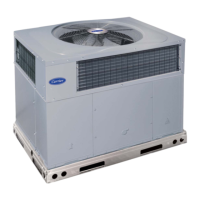1. Place room thermostat SYSTEM switch in OFF position.
Observe that blower motor starts when FAN switch is placed
in ON position and shuts down after 30 second fan time delay
expires when FAN switch is placed in AUTO position.
2. Place SYSTEM switch in COOL position and FAN switch in
AUTO position. Set cooling control below room temperature.
Observe that compressor, condenser fan, and evaporator
blower motors start. Observe that compressor and outdoor fan
shut down when control setting is satisfied and that indoor
blower shuts down after 30 second fan time delay expires.
3. When using an auto-changeover room thermostat, place both
SYSTEM and FAN switches in AUTO positions. Observe that
unit operates in heating mode when temperature control is set
to “call for heating” (above room temperature) and operates in
cooling mode when temperature control is set to “call for
cooling” (below room temperature).
IMPORTANT:
CHECKING AND ADJUSTING REFRIGERANT CHARGE
The refrigerant system is fully charged with R-22 refrigerant,
tested, and factory-sealed.
NOTE: Adjustment of the refrigerant charge is not required
unless the unit is suspected of not having the proper R-22 charge.
A superheat charging chart is attached to the outside of the service
access panel. The chart includes the required suction line tempera-
ture at given suction line pressures and outdoor ambient tempera-
tures (See Fig. 13).
An accurate superheat, thermocouple- or thermistor-type ther-
mometer, and a gauge manifold are required when using the
superheat charging method for evaluating the unit charge. Do not
use mercury or small dial-type thermometers because they are not
adequate for this type of measurement.
NOTE: Allow system to operate in the cooling mode for a
minimum of 10 minutes before checking or adjusting refrigerant
charge.
EQUIPMENT DAMAGE HAZARD
Failure to follow this caution may result in unit component
damage.
When evaluating the refrigerant charge, an indicated adjust-
ment to the specified factory charge must always be very
minimal. If a substantial adjustment is indicated, an abnormal
condition exists somewhere in the cooling system, such as
insufficient airflow across either coil or both coils.
Proceed as follows:
1. Remove caps from low- and high-pressure service fittings.
2. Using hoses with valve core depressors, attach low- and
high-pressure gauge hoses to low- and high-pressure service
fittings, respectively.
3. Start unit in Cooling mode and let unit run until system
pressures stabilize.
4. Measure and record the following:
a. Outdoor ambient-air temperature (°F db).
b. Suction-tube temperature (°F) at low-side service fitting.
c. Suction (low-side) pressure (psig).
5. Using “Cooling Charging Charts” compare outdoor-air tem-
perature (°F db) with the suction line pressure (psig) to
determine desired system operating suction line temperature.
(See Fig. 13.)
6. Compare actual suction-tube temperature with desired
suction-tube temperature. Using a tolerance of ±3°F, add
refrigerant if actual temperature is more than 3°F higher than
proper suction-tube temperature, or remove refrigerant if
actual temperature is more than 3°F lower than required
suction-tube temperature.
NOTE: If the problem causing the inaccurate readings is a
refrigerant leak, refer to Check for Refrigerant Leaks section.
INDOOR AIRFLOW AND AIRFLOW ADJUSTMENTS
For cooling operation, the recommended airflow is 350 to 450
cfm for each 12,000 Btuh of rated cooling capacity.
Table 5 shows cooling airflows at various external static pressures.
Refer to these tables to determine the airflow for the system being
installed.
NOTE: Be sure that all supply- and return-air grilles are open,
free from obstructions, and adjusted properly.
ELECTRICAL SHOCK HAZARD
Failure to follow this warning could result in personal injury
or death.
Disconnect electrical power to the unit and install lockout tag
before changing blower speed.
Airflow can be changed by changing the lead connections of the
blower motor.
All 50SD units are factory wired for low speed, except sizes 030
and 048 which are wired for medium speed.
FOR 208/230V
For color coding on the 208/230V motor leads, see Table 4.
To change the speed of the indoor fan motor (IFM), remove the fan
motor speed leg lead from the time delay relay (TDR). This wire
is attached to terminal–3 of TDR. To change the speed, remove
and replace with lead for desired blower motor speed. Insulate the
removed lead to avoid contact with chassis parts.
COOLING SEQUENCE OF OPERATION
With the room thermostat SYSTEM switch in the COOL position
and the FAN switch in the AUTO position, the cooling sequence
of operation is as follows:
When the room temperature rises to a point that is slightly above
the cooling control setting of the thermostat, the thermostat
completes the circuit between thermostat terminal R to terminals Y
and G. These completed circuits through the thermostat connect
contactor coil (C) (through unit wire Y) and time delay relay
(TDR) (through unit wire G) across the 24-v secondary of
transformer (TRAN).
The normally open contacts of energized contactor (C) close and
complete the circuit through compressor motor (COMP) to con-
denser (outdoor) fan motor (OFM). Both motors start instantly.
The set of normally open contacts of energized relay TDR close
and complete the circuit through evaporator blower (indoor) fan
motor (IFM).
Table 4—Color Coding for 208/230–V Motor Leads
BLACK = HIGH SPEED
Blue = Medium Speed
Red = Low Speed
13

